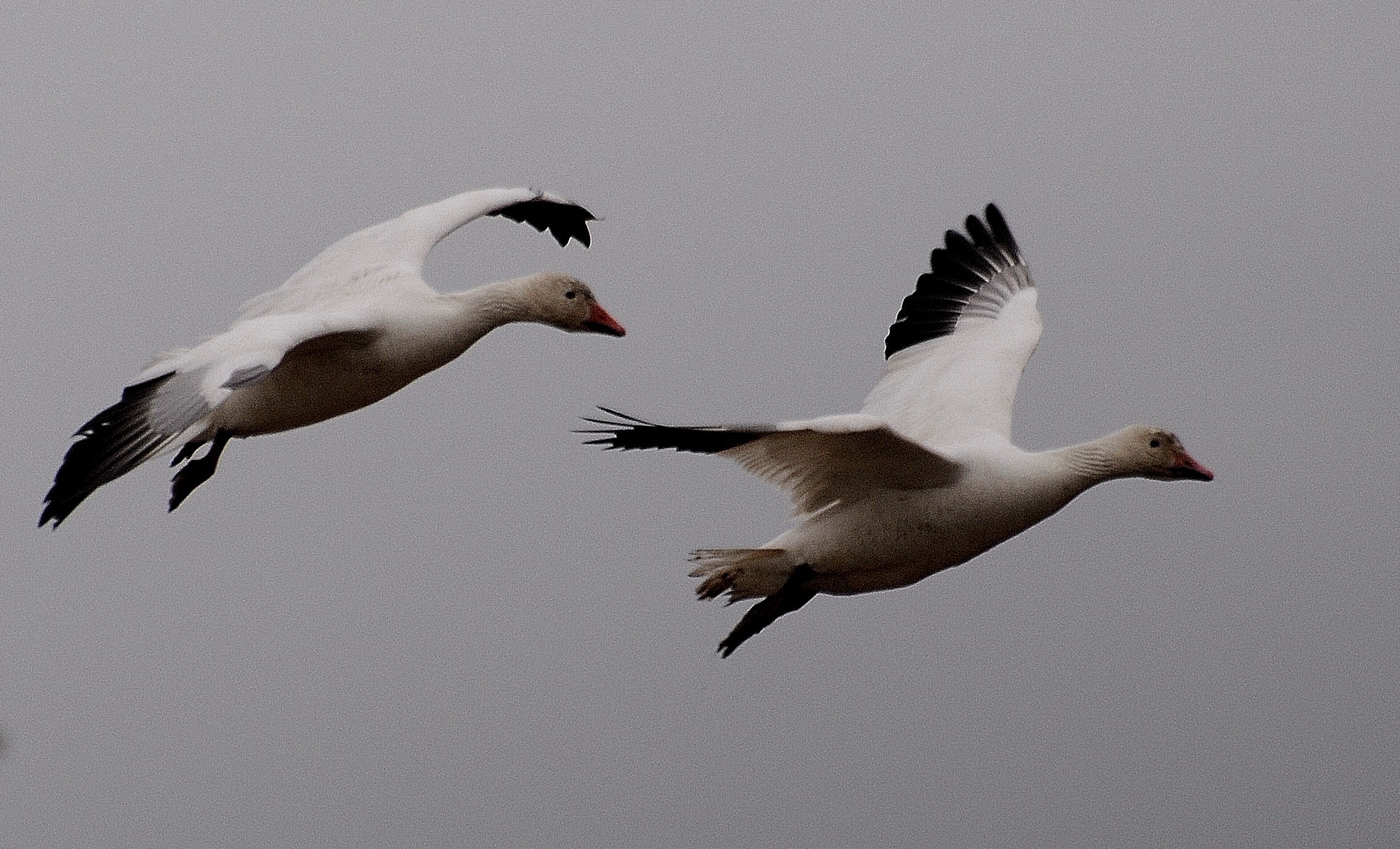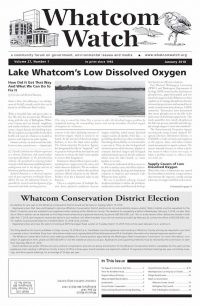by Joe Meche
Fellow watchers often ask me to provide a list of my favorite places to see birds in winter, without having to spend half the day getting there! That’s easy to do because I go to the same three places throughout the colder months. In fact, in the first week of December I visited all three of my recommendations within three days. These places are all within a 50-mile radius of Bellingham. They all offer great opportunities to see not only good numbers of birds but also a variety of species. These sites offer great walking potential to stretch the legs and breathe in a little fresh air. All three are suitable for those with disabilities who might be car-bound for obvious reasons. Two are highly accessible for handicapped birders who require wheelchairs.
Blaine/Semiahmoo
If you’ve read this column for any length of time, you’ve heard me sing the praises of this area. It stands as one of the premier components of Washington’s Important Bird Areas Program, as well as the cornerstone for the Great Washington State Birding Trail. The overall concentrations of birds in this area throughout the winter bring birders from other parts of the country where ice is the general rule of thumb. Our moderate marine climate ensures ice-free waters and protected estuaries offer protection from stormy weather.
Waterfowl dominate the scene in Drayton Harbor and Semiahmoo Bay. Dabbling ducks and diving ducks, sea and bay ducks, loons, grebes, and scoters are always active, utilizing the rich resources of this productive ecosystem. In addition to the waterfowl are spectacular flocks of dunlin and the raptors that pursue them, like peregrine falcons and merlins. Bald eagles and Cooper’s hawks keep many other birds on alert, as well.
If you wish to expedite your trip take I-5 north and take the last Blaine exit before the border crossing. Utilize two roundabouts to go under the freeway and cross the tracks to a spacious parking area on the right at Marine Park. This is where I begin my own walking tour of the entire Blaine waterfront, including the public pier at the end of Marine Drive and the boat launch area. After you’ve covered the waterfront, drive the perimeter of Drayton Harbor to the Semiahmoo Spit and to the tip of the spit, known as Tongue Point. This is the best spot to view the activity across the channel to White Rock, BC. If you have time to meander, as I usually try to do, consider taking back roads from Bellingham to cover the Lummi Flats, Lake Terrell, and Birch Bay along the way.
Skagit Flats/Samish Flats
When it comes to raptors and larger waterfowl like swans and snow geese, these two Skagit County sites are best in the Northwest. Before we get too far afield, however, I feel it’s important to point out the difference between these two excellent birding venues. The main difference is one of geography, and if you’re reporting a rare bird it’s good to know where you are. The easy way to remember is that the greater Skagit Flats is south of State Highway 20 and the Samish Flats is to the north. The main focus of the Skagit Flats is Fir Island and the surrounding area. For the Samish Flats, the town of Edison serves as the central point of reference.
To get right to the best part of the Skagit Flats, drive south on I-5 and take the Conway exit to Fir Island Road. Once you cross the South Fork of the Skagit River, you’re on Fir Island. For many years there has been no better place to view trumpeter and tundra swans, and a variety of raptors. While the Skagit Flats might have the lion’s share of swans and geese, the Samish Flats gets the nod for raptors, like eagles, falcons, short-eared owls, harriers, and the occasional rarity, the gyrfalcon. A casual drive along the Chuckanut shoreline will take you right into the back door of the Samish Flats.
Reifel Redux
I saved the longest drive for last but it might well be the best of the three, in my humble opinion. It requires a little more work, not only in the driving end of things but also that you’ll be crossing the U.S./Canada border twice. With the required paperwork in hand, however, it’s a relative piece of cake, depending on the time of day and day of the week. I plan all my trips to the George C. Reifel Migratory Bird Sanctuary (Reifel) for Tuesday, Wednesday, or Thursday. It’s never a good idea to get too close to the beginning or the end of a Canadian holiday weekend.
Reifel is the epitome of the word sanctuary and the birds that flock to the refuge seem to understand and embrace the concept. There aren’t many places where you can see black-crowned night herons roosting right next to the main entry gate. For some reason, they’re always in the same general area and nowhere else on the refuge. For introducing young kids to birds, the entry trail is always a treat with a variety of waterfowl waiting for handouts. The refuge maintains the practice of feeding birds approved bird seed that can be purchased at the gate. Proceeds from these sales help to fund maintenance projects on the refuge.
Once you get past the relative chaos of the entry, the trails are open to whichever direction you wish to take. A forested trail on the east bank leads to the best places to see great horned and saw-whet owls. Connecting trails wind throughout the refuge and eventually lead to the West Marsh where thousands of snow geese and swans feed along the saltwater shoreline. The inner marsh area is always good for shorebirds and more waterfowl. A stop at the observation tower is essential to fully grasp the size and layout of the refuge.
Getting back to the starting point is simply a matter of following trails back through the heart of the refuge. On the inner trails, get ready for waterfowl! Mergansers share space with ring-necked ducks, wigeons, pintails, buffleheads, shovelers, and mallards. In the heart of the refuge is a nesting area for sandhill cranes. While the cranes are approachable enough in winter, they seem to develop an attitude during the nesting season, so be aware of their sharp bills throughout the year.
Getting to Reifel is relatively easy, considering the border crossing and the usual rush into and out of Vancouver. Follow the signs as the interstate turns into Hwy. 99 and take Exit 20, the Ladner Trunk Rd. This road takes you through the village of Ladner and eventually across the South Arm of the Fraser River to Westham Island and this world-class birding site. On the way to or from the refuge, allow a little time to take the 72nd St. exit and drive to the end of the road at the Boundary Bay Dyke. Shorebirds and raptors are the big attractions at Boundary Bay and a major wintering location for snowy owls during irruption years.
No matter which of these three you choose to visit, plan ahead to take your own food and drink. Even though restaurants are available here and there, when I go birding, I prefer to stay in the field as opposed to sitting inside and losing the rhythm of the hunt. Of course, if it’s really cold or wet, these establishments serve a useful purpose. Even the hard-core birder will succumb to the warmth and aromas of a good coffee house/bakery on a cold January day.
George Reifel Field Trip, March 16, 2018
As part of the Wings Over Water Northwest Birding Festival, there will be a full-day guided tour of the refuge, with very comfortable bus transportation provided. For details and/or to sign on for the tour, visit the Wings Over Water website at www.wingsoverwaterbirdingfestival.com.
__________________________________
Joe Meche is a past president of the North Cascades Audubon Society and was a member of the board of directors for 20 years. He has been watching birds for more than 60 years and photographing birds and landscapes for more than 40 years. He has written over 160 columns for Whatcom Watch.






























